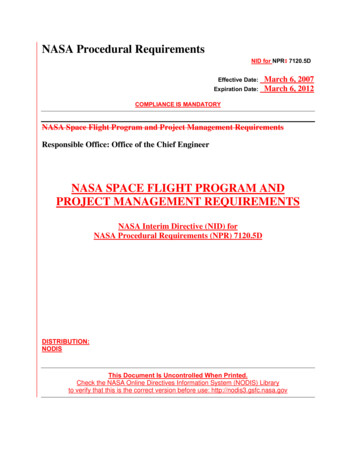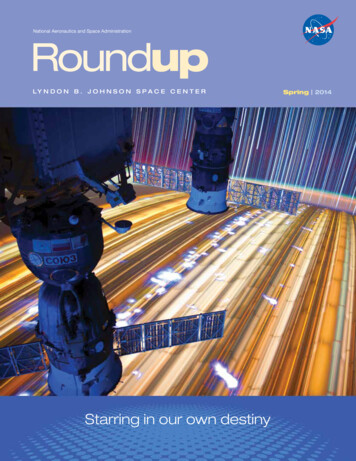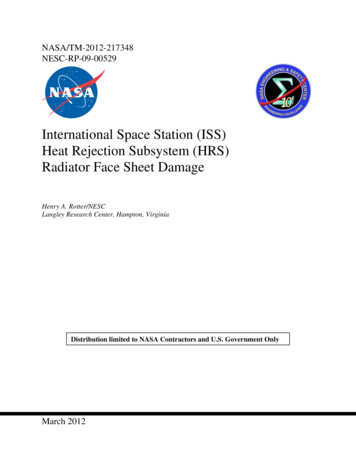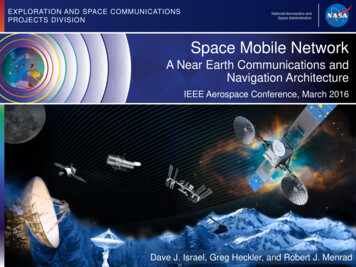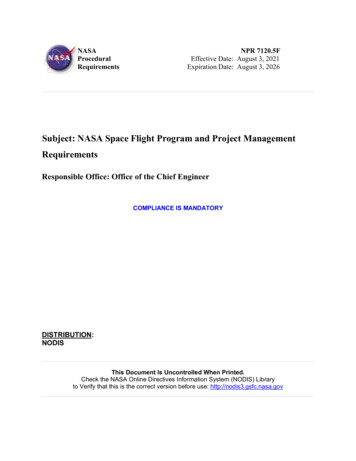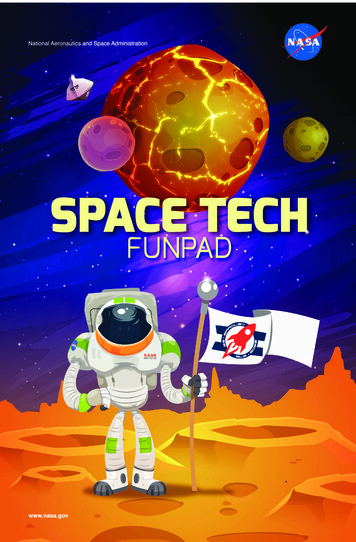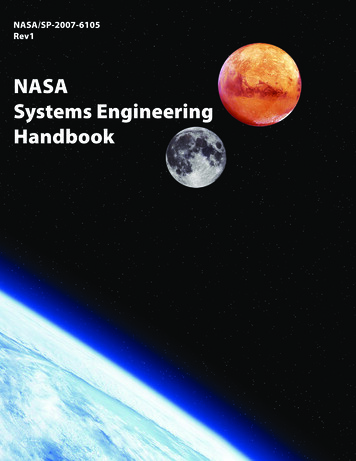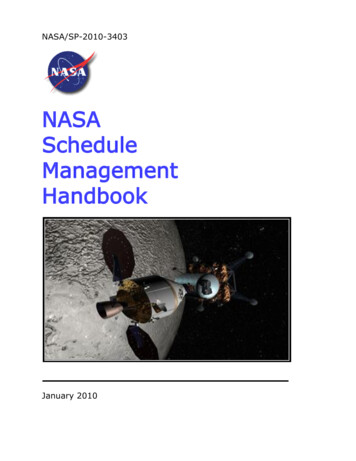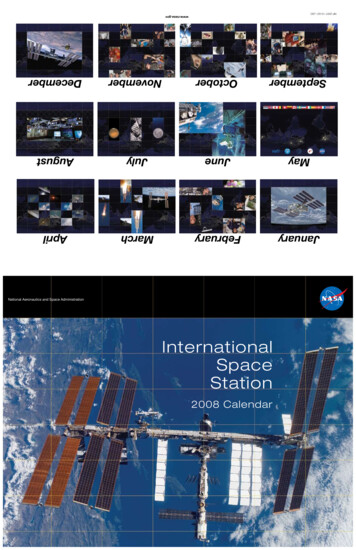
Transcription
2008 CalendarInternationalSpaceStationNational Aeronautics and Space NP-2007-10-021-JSC
The International Space Station (ISS) is the largest and most complicated spacecraft everbuilt. It is allowing NASA to conduct scientific research to improve life on Earth and toprepare for long-duration space flights to the moon and other destinations.008December2SMTWTFS171972 – Apollo 17 launch.Final Apollo mission1421288392006 – STS-116 (ISS, P5truss) launch1516222329301965 – Gemini VI-Alaunch. Gemini VI-A and VIIsuccessfully rendezvous1970 – Venera 7 (U.S.S.R.)first spacecraft to land onanother planet (Venus)Winter Solstice—Winter begins1968 – Apollo 8 launch2Orion Statistics:Crew sizeDiameterPressurized volume45610111213171819202425 Christmas26271988 – STS-27 launch1973 – Pioneer 10 flyby of1990 – STS-35 launchJupiter. First flyby of outer1992 – STS-53 launchplanet1993 – STS-61 (HubbleSpace Telescope servicing)launch6 (ISS missions)16.5 feet692 cubic feet1903 – Wright brothersfirst flight1968 – Apollo 8 becomesfirst crewed mission toorbit the moon1999 – STS-103 (HubbleSpace Telescope servicing)launch314 (moon missions)5 meters20 cubic meters5:1965 – Gemini VII launch2001 – STS-108 (ISS,1998 – STS-88 (ISS, Unity Expedition 4) launchConnecting Module)launch. First U.S. ISSsegment12:For more information about the Constellation Program, please visit:http://www.nasa.gov/mission pages/constellation/main/index.html19:27:
NASA’s Constellation Program is currently building the next-generation vehicle that willvisit the International Space Station (ISS). The Orion crew exploration vehicle will ferrycrew members to and from Earth and the ISS beginning in the next decade. Orion willbe launched atop the Ares I rocket. The Orion will also be used to send astronauts tothe moon. In addition to Orion and Ares I, Constellation is also developing a heavy cargolaunch vehicle, Ares V.008January2SMTWTFS1 New Year’s Day67813141520211993 – STS-54 (TDRS-F;DXS) launch271967 – Apollo 1 fire1968 – Surveyor (moon)launch1998 – Lunar Prospectorlaunch28Martin LutherKing, Jr. Day1986 – STS-51L launch.Space Shuttle Challengeraccident21959 – Luna 1 becomesfirst spacecraft to reachescape velocity and orbitthe sun91016171990 – STS-32 (SYNCOMIV-F5) launch2003 – STS-107(Spacehab) launch222329301968 – Apollo 5 launch1992 – STS-42 (IML-1)launch1998 – STS-89 (ShuttleMir) launch1998 – IntergovernmentalAgreement on SpaceStation Cooperationsigned32004 – Spirit rover landson Mars4111996 – STS-72 (TSS-1R;USMP-3) launch18241985 – STS-51C (DOD)launch1986 – Voyager 2 Uranusflyby2004 – Opportunity roverlands on Mars251984 – President RonaldReagan announces U.S.plans to build a spacestation5121986 – STS-61C(SATCOM KU-1) launch1997 – STS-81 (Shuttle Mir) launch191965 – Gemini II launch26311958 – Explorer 1 launch.First U.S. satellite1961 – Mercury 2 launch1971 – Apollo 14 launchWhen the ISS is complete: Its solar arrays will span 243 feet (74 meters), which is longer than thatof a Boeing 777 200/300 model It will have 32,300 cubic feet (915 cubic meters) or equal to that of a Boeing 747 It will measure 356 feet (108.5 meters) or equivalent to a football fieldFor more information about the ISS, please visit: www.nasa.gov8: It will have 52 computers to control its systems15:22:30:
Science on the International Space Station (ISS) focuses on human research andtechnology development to pave the way for future exploration of the solar systemand to improve life on Earth.008November2SMTWTFS12Daylight-Saving Timeends2000 – Expedition 1arrives at ISS. Continuoushuman occupation of ISSbegins31973 – Mariner 10 launch.First spacecraft to exploreMercury1994 – STS-66 (ATLAS-3;CRISTA-SPAS) launch4511 Veterans Day129101617182324251967 – Apollo 4 launch1973 – Skylab 4 launch61966 – Gemini XII launch1995 – STS-74 (Shuttle1982 – STS-5 launch. First Mir) launchspace shuttle operationalmission2002 – STS-113 (ISS, P1 1991 – STS-44 (DOD)truss, Expedition 6) launch launch191996 – STS-80(ORFEUS-SPAS II WSF-3)launch1997 – STS-87 (U.S.Microgravity-4) launch2671996 – Mars GlobalSurveyor launch131971 – Mariner 9 (Mars)first spacecraft to orbitanother planet201998 – Zarya ControlModule launch. ISSconstruction begins27 Thanksgiving1985 – STS-61B (3satellites) launch30141969 – Apollo 12 launch212881984 – STS-51A (3satellites) launch151990 – STS-38 (DOD)launch221989 – STS-33 (DOD)launch291964 – Mariner 4 (Mars)launch1983 – STS-9 launch. Firstnon-American participatesin U.S. missionFor more information on living in space. please dex.html2000 – STS-97 (ISS, P6truss) launch. First set ofISS solar arrays5:13:19:27:
2008FebruarySMTWTFS12789151622232003 – STS-107 (SpaceShuttle Columbia) accident31984 – STS-41B launch1994 – STS-60 launch1995 – STS-63 launchFirst female shuttle pilot10171965 – Ranger 8 (moon)launch244561112131420211997 – STS-82 (HubbleSpace Telescope servicing)launch1999 – STS-99 (SRTM)launch18Presidents’ Day1977 – Space ShuttleEnterprise first flight test191962 – Mercury-Atlas 6(Friendship 7). John Glennfirst American to orbitEarth26251966 – Apollo/Saturn 201launch13:1996 – STS-75 (TSS-1R;USMP-3) launch2827Expedition 1 began the permanent habitation of the International Space Station (ISS) onNov. 2, 2000. Since then, crews have been working, eating, sleeping, exercising and per forming other functions of everyday life on the orbital outpost. The Expedition crews living6:1984 – STS-41Bastronauts conduct firstuntethered spacewalks2001 – STS-98 (ISS,Destiny Laboratory) launch1990 – STS-36 (DOD)launch29on the station are helping NASA develop techniques for future explorers to better over come the challenges of space flight life. To help make life on the ISS more like life on Earth,crews are also learning how to celebrate holidays, such as Thanksgiving, in space.20:28:2008FebruarySMTWTFS12789151622232003 – STS-107 (SpaceShuttle Columbia) accident31984 – STS-41B launch1994 – STS-60 launch1995 – STS-63 launchFirst female shuttle pilot10171965 – Ranger 8 (moon)launch244561112131420211997 – STS-82 (HubbleSpace Telescope servicing)launch1999 – STS-99 (SRTM)launch18Presidents’ Day1977 – Space ShuttleEnterprise first flight test2519261984 – STS-41Bastronauts conduct firstuntethered spacewalks2001 – STS-98 (ISS,Destiny Laboratory) launch1962 – Mercury-Atlas 6(Friendship 7). John Glennfirst American to orbitEarth1966 – Apollo/Saturn 201launch1996 – STS-75 (TSS-1R;USMP-3) launch28271990 – STS-36 (DOD)launch29For more information about ISS science, please visit:www.nasa.gov/mission v/mission pages/station/science/payload ops.html6:13:20:28:
More than 80 flights are scheduled during construction of the International Space Station.These missions deliver equipment, modules, supplies and crew members to the station.The international fleet of vehicles includes the space shuttle (U.S.), Soyuz (Russia),Progress (Russia), H-II Transfer Vehicle (Japan), and Automated Transfer Vehicle (Europe).The space shuttle, Soyuz and Progress spacecraft are featured above.2008OctoberSMTWTFS127891415161723241958 – NASA officiallybegins operations561213 Columbus Day1984 – STS-41G (Earth1990 – STS-41 (Ulysses)Radiation Budget Satellite) launchlaunch1964 – Voskhod 1(U.S.S.R.) launch. Firstflight with multiple crewmembers191967 – Mariner 5 Venusflyby262002 – STS-112 (ISS, S1truss) launch2004 – ISS Expedition 10launch202127281995 – STS-73 (U.S.Microgravity Laboratory)launch1977 – Last free-flight testfor Space ShuttleEnterprise221992 – STS-52 (USMP-1;LAGEOS II) launch291998 – STS-95(SPACEHAB) launch. JohnGlenn returned to space31962 – Mercury-Atlas 8(Sigma 7) launch1985 – STS-51J (DOD).Space Shuttle Atlantis’first flight102007 – ISS Expedition 16launch. Peggy Whitsonfirst female ISScommander2007 – STS-120(ISS, Harmony connectingmodule) launch30311985 – STS-61A (D-1Spacelab Mission) launch2000 – ISS Expedition 1launch. First ISS crew41957 – First satellite,Sputnik 1 (U.S.S.R.), launch1959 – Mercury Little Joe6 launch111958 – Pioneer I launch.First NASA launch1968 – Apollo 7 launch.First crewed Apollo mission2000 – STS-92 (ISS, Z1truss) launch181989 – STS-34 (Galileo)launch1993 – STS-58 (SpacelabLife Sciences-2) launch2003 – ISS Expedition 8launch251961 – Mississippi TestFacility (Stennis SpaceCenter) establishedFor more information about ISS and other NASA spinoffs, please ://www.nasa.gov/mission a.gov/tto/7:14:21:28:
NASA research not only helps the United States reach its space exploration goals, itinvolves the creation of “spinoffs” that improve life on Earth or experiments that havetremendous potential for Earth application. These spinoffs stem from technologies createdto support the International Space Station (ISS). Areas of everyday life that have benefittedfrom ISS spinoffs include water purification, manufacturing, sports, construction, aviationsafety, robotics, vision enhancement, exercise and medicine.2008MarchSMTWTFS12002 – STS-109 (HubbleSpace Telescope servicing)launch234591011121617181925261972 – Pioneer 10 launch.First spacecraft to visitouter planet and leavesolar system1995 – STS-67 (ASTRO-2)launchDaylight-Saving Timebegins1926 – First liquid fueledrocket launch1966 – Gemini VIII launch.First successful docking oftwo spacecraft1959 – Pioneer 4 launch. 1994 – STS-62 (USMP-2;First successful lunarOAST-2) launchmission by U.S. spacecraft1969 – Apollo 9 launch23241965 – Gemini III launch.First manned mission ofGemini Project1992 – STS-45 (ATLAS-1)launch30311965 – Cosmonaut AlexeiLeonov becomes the firstperson to spacewalk671314202127281989 – STS-29 (TDRS-D)launchVernal Equinox—Spring begins82001 – STS-102 (ISS,Expedition 2) launch. Firstcrew rotation. Firstmulti-purpose logisticsmodule flight15221982 – STS-3 launch1996 – STS-76 (Shuttle Mir) launch292006 – ISS Expedition 13launchFor more information about these vehicles, please visit:http://www.nasa.gov/mission ission pages/station/science/partners.html7:14:21:29:
The Crew Earth Observations (CEO) experiment: The International Space Station (ISS)provides a unique opportunity for its crew members to observe and photograph naturaland human-made changes on Earth. The photographs also record events such as storms,floods, fires and volcanic eruptions. CEO provides researchers with vital, continuousimages to better understand the planet.2008SeptemberSMTWTFS1 Labor Day71995 – STS-69 (Spartan201-03, WSF-2) launch142001 – Pirs dockingcompartment launch81960 – Marshall SpaceFlight Center dedicated1967 – Surveyor 5 (moon)launch2000 – STS-106 (ISS,supply) launch1521222003 – Galileo firstspacecraft to enterJupiter’s atmosphereAutumal Equinox—Autumn begins28291988 – STS-26 (TDRS-C)launch. First shuttle flightfollowing the SpaceShuttle Challengeraccident231976 – Viking 2 lands onMars910161723241975 – Viking 2 launch1994 – STS-64 launch2006 – STS-115 (ISS,P3/P4 truss) launch1996 – STS-79 (ShuttleMir) launch451977 – Voyager 1 launch111997 – Mars GlobalSurveyor enters Martianorbit182007 – ISS Expedition 14launch25121966 – Gemini XI launch1991 – STS-48 launch1992 – STS-47 launch1993 – STS-51 launch191961– Houston, Texas,announced as site ofNASA’s Manned SpaceFlight Center (JohnsonSpace Center)266131961 – Mercury-Atlas 4launch201966 – Surveyor 2 (moon)launch271992 – Mars Observerlaunch1997 – STS-86 (ShuttleMir) launch301994 – STS-68 launch2005 – ISS Expedition 12launchNASA ISS Education program Web sites:NASA Education — http://education.nasa.gov/EarthKAM — http://www.earthkam.ucsd.edu/NASA Explorer Schools — http://explorerschools.nasa.govNASA Digital Learning Network — http://education.nasa.gov/dln7:NASA Central Operation of Resources for Educators (CORE) — http://education.nasa.gov/coreNASA Educator Resource Center Networks (ERCN) — http://education.nasa.gov/ercnEngineering Design Challenge — r Radio International Space Station — o/15:22:29:
The International Space Station (ISS) is an orbital classroom for students around theworld who have been treated to on-orbit demonstrations from the ISS Expedition crews.Students can also participate in interactive education programs such as EarthKAM orcompare plants grown on Earth to plants grown on the station. NASA has numerousresources available to help students learn about space and all of the professionsnecessary to carry out NASA’s programs.AS pM r iT l W 2T 0 F0 S816781984 – STS-41C launch.First orbital satellite repairmission2007 – ISS Expedition 15launch1964 – Gemini I test flight1993 – STS-56 (ATLAS-2;SPARTAN-201) launch2002 – STS-110 (ISS, S0truss) launch1314152021222728291991 – STS-39 (DOD)launch1985 – STS-51B(Spacelab-3) launch239101959 – NASA announcedMercury 7. NASA’s firstastronaut class1994 – STS-59 (SRL-1)launch161972 – Apollo 16 launch233041973 – Pioneer 11 launch1991 – STS-37 (GammaRay Observatory) launch1970 – Apollo 13 launch1961 – Cosmonaut YuriGagarin becomes firsthuman in space1981 – STS-1 launch. Firstspace shuttle (Columbia)mission11171998 – STS-90 (Neurolab)launch51968 – Apollo 6 launch1983 – STS-6 (TDRS-1)launch. Space ShuttleChallenger first flight1997 – STS-83 (MSL-1)launch182004 – ISS Expedition 9launch12192001 – STS-100 (ISS,Canadarm2) launch2425261967 – Soyuz 1 accident.First human to die duringmission1990 – STS-31 (HubbleSpace Telescope deploy)launch2003 – ISS Expedition 7launch1993 – STS-55 (D-2Spacelab) launchCEO also allows the crew to share their view of the Earth with the public. CEO imagery isavailable at: http://eol.jsc.nasa.gov/5:12:20:28:
Not only is the International Space Station (ISS) the most complex scientific and technological endeavor ever undertaken, it is a shining example of international cooperation. TheISS is a partnership of five space agencies—NASA, Roskosmos (Russia), the EuropeanSpace Agency, Japan Aerospace Exploration Agency and the Canadian Space Agency.2008AugustSMTWTFS1342007 – Phoenix MarsLander launch561213101117181925262001 – STS-105 (ISS,Expedition 3) launch24311977 – Space ShuttleEnterprise first free-flighttest2005 – Mars Reconnais sance Orbiter launch1966 – Apollo/Saturn 202launch1981 – Voyager 2 Saturnflyby1989 – Voyager 2 Neptuneflyby720278914151621222328291997 – STS-85 (CRISTASPAS-02) launch1975 – Viking 1 (Mars)launch1977 – Voyager 2 launch1985 – STS-51I launch21991 – STS-43 (TDRS-E)launch1975 – Gemini V launch1978 – Pioneer 13 (Venus)launch1989 – STS-28 launch2007 – STS-118 (ISS, S5truss) launch301983 – STS-8 launch.Guion Bluford, Jr. firstAfrican-American in space1984 – STS-41D launch.Space Shuttle Discovery’sfirst flightIt is easy to track the orbit of the ISS or to learn when it is visible to humans on the ground.For more information, please visit: http://spaceflight.nasa.gov/realdata/index.htmlFor more information about the ISS, please visit: www.nasa.gov1:8:16:23:30:
With a permanent human presence aboard the International Space Station (ISS), flightcontrol teams at the Mission Control Center in Houston and the Mission Control Centerin Moscow are on duty 7 days a week, 24 hours a day, 365 days a year. Flight controllers2008WTFSMaySMT41989 – STS-30 (Magellan)launch11181969 – Apollo 10 launch251973 – Skylab 2 launch.First U.S. space stationcrewkeep a constant watch on the crew’s activities and monitor spacecraft systems, crewhealth and safety as they check every system to ensure operations proceed as planned.23891015161723561213192021222728291961 – Mercury-Redstone3 (Freedom 7) launch. FirstU.S. human (Alan ShepardJr.) space flight1996 – STS-77(SPACEHAB; SPARTAN)launch2000 – STS-101 (ISS,supply) launch26Memorial Day711992 – STS-49 (Intelsat VIRepair) launch. SpaceShuttle Endeavour’s firstflight. First 3-personspacewalk141973 – Skylab spacestation launch1963 – Mercury-Atlas 9(Faith 7) launch. FinalMercury flight1997 – STS-84 (ShuttleMir) launch301999 - STS-96 (ISS)launch. First space shuttleto dock with ISSOnce complete, the ISS will include contributions from 15 countries: the United States,Canada, Japan, Russia, Belgium, Denmark, France, Germany, Italy, the Netherlands,Norway, Spain, Sweden, Switzerland and the United Kingdom.5:11:241962 – Mercury-Atlas 7(Aurora 7) launch311966 – Surveyor I (moon)launch1971 – Mariner 9 (Mars)launchFor more information about the ISS partners, please visit:http://www.nasa.gov/mission pages/station/science/partners.html19:27:
Building and maintaining the International Space Station (ISS) requires crew members toconduct extravehicular activities (spacewalks). More than 130 spacewalks are scheduledJS uMl yT12789141521221962 – Cape Canaveral,Fla. established as launchoperations center1997 – STS-94(MSL 1 reflight) launch6131995 – STS-70 (TDRS-Gsatellite) launch202003 – Mars Exploration1994 – STS-65Rover (Opportunity) launch (International MicrogravityLaboratory) launch1965 – Mariner 4 takes1975 – Apollo-Soyuz Testfirst close-up pictures ofProject launchMars1967 – Surveyor 4 (moon)launch1969 – Apollo 11 lands on 1961 – Mercury-Redstonemoon. Neil Armstrong and 4 (Liberty-Bell 7) launchBuzz Aldrin first humans towalk on moon1976 – Viking 1 first U.S.mission to land on Mars2728291958 – NASA created1960 – Mercury-Atlas 1launch1985 – STS-51F(Spacelab-2) launch2:2008WTFS3410161723241969 – Apollo 11 launch30Independence Day1997 – Mars Pathfinderlands on red planet2006 – STS-121 (ISS,supply) launch1962 – Launch ofTelstar-1, first commercialcommunications satellite1999 – STS-93 (ChandraX-ray Telescope) launch.Eileen Collins first femalespace shuttle commander1964 – Ranger 7 (moon)launch1973 – Skylab 3 crewlaunchFor more information about the first moon landings, please ndex.htmlto take place during the ISS assembly. To prepare for the spacewalks, crew members trainin a 6.2-million-gallon pool at the Neutral Buoyancy Laboratory (NBL) in Houston, Texas.1151966 – Apollo/Saturn 203launch121979 – Skylab reenteredEarth’s atmosphere2000 – ISS ZvezdaService Module launch2001 – STS-104 (ISS,Quest Airlock) launch18191966 – Gemini 10 launch25261963 – Syncom 2 launch1971 – Apollo 15 launch2005 – STS-114 (ISS)launch. Space shuttlereturn to flight mission311992 – STS-46 (EURECA,TSS-1) launchFor more information about NASA’s long-duration spaceflight research, please visit:http://www.nasa.gov/mission pages/station/science/experiments/Human nginspace/10:18:25:
International Space Station is playing a vital role in that preparation as a testbed forlong-duration space flight.Humankind’s greatest achievement in space occurred at 10:56 p.m. EDT, July 20, 1969,when Astronaut Neil Armstrong became the first human to walk on the moon. The UnitedStates is working to return astronauts to the moon and to explore other destinations. TheJuneSMT182007 – STS-117 (ISS,S3/S4 truss) launch1522291995 – Space ShuttleAtlantis becomes firstshuttle to dock withRussian Mir space station21966 – Surveyor Ibecomes first U.S.spacecraft to soft land onmoon1998 – STS-91 (ShuttleMir) launch9161963 – CosmonautValentina Tereshkovabecomes first female inspace232008WTFS34101112181925261965 – Gemini IV launch.Ed White conducts firstU.S. spacewalk1966 – Gemini IX-A launch2003 – Mars ExplorationRover (Spirit) launch171985 – STS-51G launch2451991 – STS-40 (SpacelabLife Sciences-1) launch2002 – STS-111 (ISS,Expedition 5) launch1983 – STS-7 launch.Sally Ride first U.S. femalein space1992 – STS-50 (USML-1)launch6713141983 – Pioneer 10 firstspacecraft to leave solarsystem20Summer SolsticeSummer begins1996 – STS-78 (LMS)launch271982 – STS-4 (DOD)launch1995 – STS-71 launch.First Shuttle-Mir docking211993 – STS-57(SPACEHAB) launch28301971 – Soyuz 11 accidentISS-based spacewalkers can begin their EVAs out of the Quest Airlock (U.S.) or Pirs Docking Compartment (Russia). Spacewalks can also be based from a visiting space shuttle.For more information about ISS construction activities, please visit:http://www.nasa.gov/mission pages/station/main/index.htmlNBL Pool Dimensions: 202 feet long, 102 feet wide and 40 feet deep.3:10:18:26:
Regards,Michael T. SuffrediniISS Program ManagerThis calendar is designed to inspire the next generation of explorersand to provide knowledge and information to educators, students,and anyone who is interested in space. I hope you will enjoy it andthat you will learn something new about NASA and the ISS throughout the year.The International Space Station (ISS) is one of the greatest international, technological, political, and engineering achievements inhuman history. The research and science that is performed on ISStoday will help us obtain the experience and develop the proceduresand hardware that will enable us to return to the moon and beyond aswe continue humankind’s quest of exploration.
2008 Calendar International Space Station Januar y Februar y March April May June July August September October November December www.nasa.gov . It is allowing NASA to conduct scientiic research to improve life on Earth and to prepare for long-duration space lights to the moon and other destinations. D S ec M em T be W r2 0 0 8 T F S
